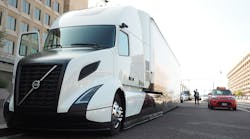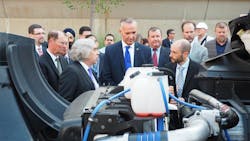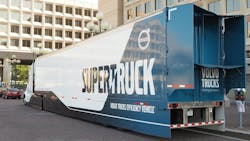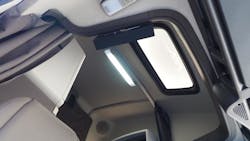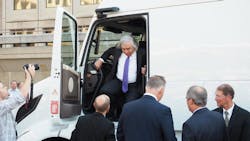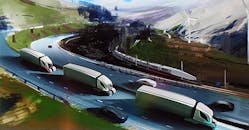WASHINGTON, DC. At Volvo's unveiling Tuesday of the truck it produced under the Dept. of Energy's (DOE) SuperTruck project, the company said the effort had been illuminating, helping its engineers design a vehicle not by improving this or that element but as a whole.
"We looked at it as a knowledge accelerator," said Göran Nyberg, president of Volvo Trucks North America. "It's a milestone in our history."
Part of DOE's objective with this project — and for the next iteration of it announced earlier this year — is feasibility, the idea being to produce technologies and innovations that'll actually make it into trucks on North American roads. Volvo took an accordingly measured approach to its SuperTruck, Nyberg explained, considering practicality for commercial production of the different technologies employed.
U.S. Sec. of Energy Ernest Moniz toured the Volvo SuperTruck outside the department's headquarters and expanded on that point. "I think a big part of it is going to be to keep working on the engineering to get the costs down so that these efficient trucks become the standard in the United States and frankly, in the global market," he said, noting ongoing efforts under SuperTruck II.
Speaking more on that global outlook, Moniz also pointed to heavy pollution problems in places like China and India and said improving freight efficiency could eventually help there as well. "We are doing this to accelerate the introduction of these technologies," he told reporters. "Time is important for us in terms of fuel economy and carbon emissions."
SuperTruck I goals: check
The target for SuperTruck project participants was to deliver a truck capable of 50% greater freight efficiency than a 2009 truck baseline, and Volvo's SuperTruck overshot the goal with 88% higher freight efficiency. It's a pretty straight calculation: freight efficiency is freight tonnage multiplied by miles per gallon the vehicle gets. Per project rules, Volvo's SuperTruck efficiency was calculated with the truck loaded to 65,000 lbs. and doing a constant 64 mph.
Here are some more stats: Volvo's SuperTruck boasts more than a 70% improvement in fuel economy compared with that 2009 baseline, achieving better than 12 mpg; Nyberg said that in recent testing, the truck is hitting 13 mpg. And thanks to aerodynamic improvements on the SuperTruck, Volvo's 2016 VNL series trucks benefitted from improved bumper, chassis and roof aerodynamics good for up to a 3.5% increase in fuel economy.
In addition, as Volvo announced earlier, engine innovations that came about under the SuperTruck project can deliver up to 6.5% greater fuel efficiency in the company's 2017 powertrains. Those include common rail fuel injection, turbo compounding and Wave Piston technologies.
Instead of a typical domed piston, the Wave Piston has what look like divots all around the top that focus the injected fuel-air mixture back toward the center of the combustion chamber and promote a cleaner, more complete burn. "It's one of my personal favorites," said Pascal Amar, senior project manager for Volvo Group North America, discussing various Volvo SuperTruck technologies. "It's a relatively simple change that has a huge impact."
Amar pointed out that the SuperTruck is 3,200 lbs. lighter than a standard truck. It was more than that, though — that's a net weight. Reducing weight was even more necessary because of all the additional technology added to the truck. The Volvo team achieved the weight reduction through things like an almost entirely aluminum frame on the tractor, and "we didn't just replace steel with aluminum," Amar contended, but rather built a frame specifically taking advantage of aluminum's properties.
Still a ways off (or got nixed)
Volvo's efficiency gains under the SuperTruck program fall into two categories: aerodynamics/ vehicle-based improvements and engine/ powertrain improvements. Though some of the technological tweaks Volvo employed, as noted above, have made it into or will be available soon in production vehicles, others won't for some time.
First and foremost among those "not-yet" technologies is Rankine waste heat recovery. Turbo compounding, meanwhile, also taps waste heat, and is available on Volvo's 2017 D13 engines.
Note the difference between the two. "It's generally the same heat. Turbo compounding is extracting energy right after the main turbocharger and it's connected mechanically through a gear train to the crankshaft," explained John Gibble, who headed up Volvo's SuperTruck project from the engine and powertrain side.
But there's more waste heat than turbo compounding uses coming off the engine. In addition to exhaust gas recirculation, or EGR, technology long in place to reduce emissions, Rankine waste heat recovery "uses a working fluid that turns into steam that we send through a steam engine that also makes power," Gibble told Fleet Owner. "So a turbo compound can harvest certain energy, and waste heat recovery can do a little bit more on top of that and get energy from other sources."
Some promising technologies Volvo considered using didn't make it to the final cut. That included going with a fiberglass trailer, which would've been too expensive to bring to production, so the Volvo SuperTruck began with a standard 53-ft. trailer that engineers enhanced from there, especially the aerodynamics. "If we were going to develop the truck of the future, we had to start with the trailer of the future," Amar said.
Meanwhile, with improved aerodynamics at the front and under the hood of the tractor, between tractor and trailer and at the sides and rear of the trailer, Volvo found that aero panels underneath the truck didn't really help, Amar noted. And a hybrid electric powertrain didn't survive a cost-benefit analysis, so the OEM went with 11L diesel power in the form of its D11 engine instead.
In addition, fuel cells and an adjustable fifth wheel didn't add enough of a benefit, Volvo engineers noted, so those were considered but not included.
Solar, kinetic energy powers A/C
A subtle but important detail in the Volvo SuperTruck's operation is the air conditioning system. In order to insulate the truck's cab best, extra window glass such as a sunroof had to be eliminated, according to Amar.
Doing so, however, made it darker inside the truck. "We don't want the driver to be sitting in a cave the whole time," he noted.
But on the sunny morning in the nation's capital that graced the Volvo SuperTruck's unveiling, if you looked up inside the cab, you might've been convinced there's a sunroof up there letting in light. That effect is all done with LEDs, Nyberg explained, and is meant to give the driver a similar lighting experience to sunlight while sealing the cab off better and improving insulating properties.
Built into the roof of the Volvo SuperTruck cab is a fairly large solar panel. "The batteries that run the A/C are charged by the solar panel on the roof, or whenever your foot is on the brake, you have a 10 kW alternator in there that charges the batteries," Amar explained to Fleet Owner. "So A/C is 'free.'"
The cooling system pops on at a certain temperature even when the truck isn't running to prevent the cab from getting too hot, which would be much less efficient to then have to cool again. The SuperTruck's fully integrated hotel load system provides up to 14 hours of power to keep the driver cool at night.
Going forward
Although Volvo was staggered in this SuperTruck release somewhat behind other program participants since the company was awarded its grant later, the OEM says it will be on track with other teams participating in SuperTruck II.
"We ended SuperTruck just when we learned we had an opportunity to do it again," Amar said. "So the way we see SuperTruck II is we haven't stopped working on this."
This first SuperTruck —let's call it the Volvo ST1 — will be used in the first years of the SuperTruck II project for aerodynamics and actual use testing, but the company's next SuperTruck will be an all-new vehicle. In the meantime, two major fleets, Knight Transportation and Wegmans, will be working with Volvo to put ST1s on the road and will help learn from them.
As Energy Sec. Moniz got a tour of the Volvo SuperTruck on Tuesday, having made his way around the truck and hearing about various technology highlights, he quipped half-jokingly, "So why do you need SuperTruck II?"
Amar's enthusiastic response: "Because we finished this with so many more ideas!"
Alright, but what are we talking about — where do you wring out more efficiency in the truck now? Here's a clue: Amar had also noted earlier that "there are no more low-hanging fruits" in terms of improving freight efficiency. Now, he said he expects gains might be found by making the various components that were used more efficient — Volvo will examine things like lighter-weight components and different engine designs. Perhaps a hybrid-electric powertrain or additional electrification could find its way into the mix.
The OEM will tap vehicle telematics info to figure out exactly where the limits are to be pushed: a few examples include how many hours of auxiliary power drivers really need, what grades trucks are driven on in North America and what's required for different duty cycles such as less-than-truckload freight transport.
And the SuperTruck project will no doubt be significant in the years to come as the company designs and certifies that trucks meet ongoing standards for greenhouse gas emissions and fuel efficiency — which, like Volvo's approach to building this SuperTruck, can also consider the vehicle as a whole.
Don't miss a Fleet Owner slideshow to come with a closer look at a number of technologies built into Volvo's SuperTruck. Until then, watch more from Volvo on the SuperTruck below:
